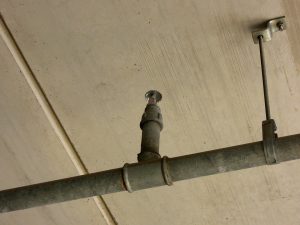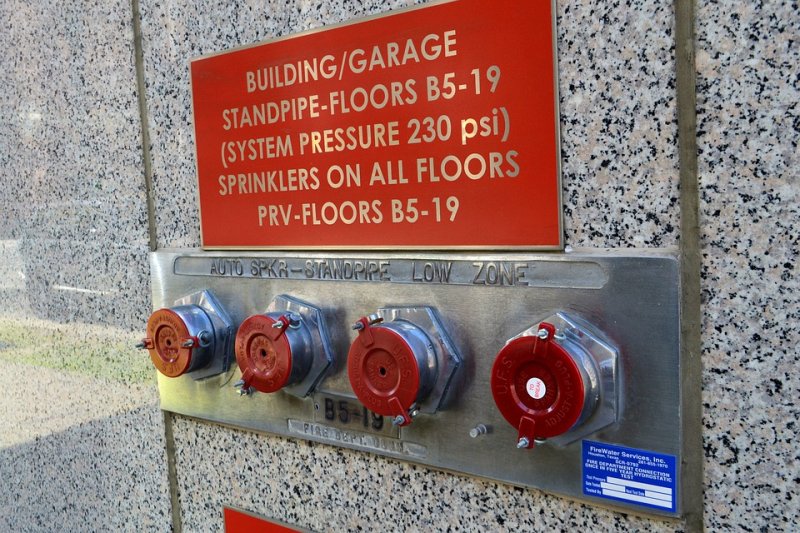Fire sprinkler systems have been around since the early 1800s and have mostly consisted of manually-operated systems that use perforated pipes to deliver  water to a certain area. It wasn’t until the late 1800s when the first automated fire sprinkler system was introduced, which even to this very day serves as the basis for virtually every type of modern-day sprinkler systems.
water to a certain area. It wasn’t until the late 1800s when the first automated fire sprinkler system was introduced, which even to this very day serves as the basis for virtually every type of modern-day sprinkler systems.
These days, automatic fire sprinkler systems are considered to be one of the top life safety and protection options that a building owner or a design team makes. As a matter of fact, building codes enforce this in that it provides various “trade-offs” that results in flexibility in terms of building design and construction.
But although building codes completely support and at times, even authorize the installation of automatic fire sprinkler systems, most of the design choices are left up to either the design team or the building owner. Design options include the type of sprinkler, type of system as well as the design approach. That’s why it’s essential to have a better understanding of common fire sprinkler system design choices and the terminology to aid both the owners and engineers when considering automatic sprinkler protection.
There are several sprinkler system types where the options depend on the type of environment of the system, the protection preferences of the owner and the hazard protected. Let’s take a look at some of the most common sprinkler systems out there today;
1. Dry Pipe Sprinklers
Dry pipe sprinkler systems are usually installed when the sprinkler systems are exposed to temperatures below 40 F. With this type of system, the piping is typically filled with compressed nitrogen or air. The sprinklers installed in dry systems are usually similar to the ones installed in wet systems.
During a fire event, the fire sprinkler system’s thermal operating element turns on and then compressed gases within the system are released. As soon as the pressure in the system drops to a certain point, a dry pipe will release water to the system piping. The valves, as well as the water-laden piping up to them, have to be contained under heated enclosures.
Air-saturated dry pipe sprinkler systems are more likely vulnerable to internal corrosion than wet pipe systems, which is why extra designs need to be considered. Those extra designs include the proper system piping pitch, and installation of extra drains on the system, usually at remote points. Dry pipe systems also need extra fire sprinkler supplies such as air compressor, a pressure monitoring switch and a dry pipe valve, which obviously increases the system’s cost and maintenance.
2. Wet Pipe Sprinklers
The usual automatic sprinkler system found in most buildings is a wet pipe system. These systems are filled with water under normal with conditions and immediately dispel water upon activation of the sprinklers. Climate-controlled buildings after where wet pipe systems are appropriate. The only time their installation is not allowed is when spaces can’t maintained temperatures above 40 F.
NFPA 13, which is a sprinkler system standard puts the responsibility of maintaining the system environment’s temperature on the owner. There are ways in which freeze protection is provided to wet sprinkler systems, including heat trace and insulation. But whether or not these options will be accepted, is up to the local authority having jurisdiction (AHJ), and they’re normally not recommended as industry best practice.
3. Deluge Sprinklers
These systems are normally installed to protect buildings from high-challenge fire hazards. These types of fires spread too quickly for normal sprinklers to be activated and get under control. Deluge isn’t installed to protect ordinary combustible items but is installed to protect fuels like flammable gases and liquid.
The sprinkler system heads in a deluge system are “open” in which they don’t have a thermal operating element. The system can be activated either manually or by fire detection and releasing system. Deluge systems can be installed in warm or cold climates due to the lack of water in system piping under regular conditions. When activated, water gets released from every sprinkler. In other systems, sprinklers get activated by the heat of the fire.
4. Antifreeze Sprinklers
This type of fire sprinkler system where buildings are exposed to freezing temperatures. The systems need a certain concentration of antifreeze to be maintained in the water-filled sprinkler piping. Be aware that common antifreeze solutions on the market can be really flammable when atomized by discharge through a sprinkler, especially if it’s not installed properly.
Conclusion
In conclusion, having the right fire sprinkler system in place is essential for protecting your property and ensuring the safety of its occupants. By understanding the different types of fire sprinkler systems available, you can make an informed decision on the best option for your specific needs. Whether you opt for a wet pipe, dry pipe, deluge, or pre-action system, investing in a reliable fire sprinkler system is a decision that can ultimately save lives and prevent costly damage.

Thanks for the article I never knew there were different types of sprinkler systems
This was interesting I never knew there are this many types of sprinkler systems